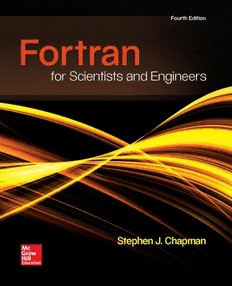Table Of ContentFourth Edition
Fort ra n
for Scientists and Engineers
Stephen J. Chapman
Fortran for Scientists
and Engineers
Fourth Edition
Fortran for Scientists
and Engineers
Fourth Edition
Stephen J. Chapman
BAE Systems Australia
FORTRAN FOR SCIENTISTS AND ENGINEERS, FOURTH EDITION
Published by McGraw-Hill Education, 2 Penn Plaza, New York, NY 10121. Copyright © 2018 by McGraw-
Hill Education. All rights reserved. Printed in the United States of America. Previous edition © 2008 and
2004. No part of this publication may be reproduced or distributed in any form or by any means, or stored in
a database or retrieval system, without the prior written consent of McGraw-Hill Education, including, but
not limited to, in any network or other electronic storage or transmission, or broadcast for distance learning.
Some ancillaries, including electronic and print components, may not be available to customers outside
the United States.
This book is printed on acid-free paper.
1 2 3 4 5 6 7 8 9 LCR 21 20 19 18 17
ISBN 978–0–07–338589–1
MHID 0–07–338589–1
Chief Product Officer, SVP Products & Director, Content Design & Delivery:
Markets: G. Scott Virkler Linda Avenarius
Vice President, General Manager, Products & Program Manager: Lora Neyens
Markets: Marty Lange Content Project Managers: Jane Mohr and
Vice President, Content Design & Delivery: Sandra Schnee
Betsy Whalen Buyer: Jennifer Pickel
Managing Director: Thomas Timp Design: Studio Montage, St. Louis, MO
Brand Manager: Raghothaman Srinivasan/ Content Licensing Specialist: DeAnna Dausener
Thomas M. Scaife, Ph.D Cover Image: hh5800/Getty Images
Director, Product Development: Rose Koos Compositor: Aptara®, Inc.
Product Developer: Tina Bower Printer: LSC Communications
Marketing Manager: Shannon O’Donnell
All credits appearing on page or at the end of the book are considered to be an extension of the copyright page.
Library of Congress Cataloging-in-Publication Data
Chapman, Stephen J., author.
Fortran for scientists and engineers / Stephen J. Chapman, BAE Systems
Australia.
Fourth edition. | New York, NY : McGraw-Hill, a business unit of
The McGraw-Hill Companies, Inc., [2017] | Includes index.
LCCN 2016052439 | ISBN 9780073385891 (alk. paper) | ISBN
0073385891 (alk. paper)
LCSH: FORTRAN (Computer program language) | Science—Data
processing. | Engineering—Data processing.
LCC QA76.73.F25 C425 2017 | DDC 005.13/3—dc23 LC record available at
https://lccn.loc.gov/2016052439
The Internet addresses listed in the text were accurate at the time of publication. The inclusion of a
website does not indicate an endorsement by the authors or McGraw-Hill Education, and McGraw-Hill
Education does not guarantee the accuracy of the information presented at these sites.
mheducation.com/highered
This book is dedicated to my son Avi, who is the
only one of our eight children actually
making a living writing software!
A B O U T T H E A U T H O R
STEPHEN J. CHAPMAN received a B.S. in Electrical Engineering from L ouisiana
State University (1975), an M.S.E. in Electrical Engineering from the University of
Central Florida (1979), and pursued further graduate studies at Rice University.
From 1975 to 1980, he served as an officer in the U.S. Navy, assigned to teach
Electrical Engineering at the U.S. Naval Nuclear Power School in Orlando, Florida.
From 1980 to 1982, he was affiliated with the University of Houston, where he ran the
power systems program in the College of Technology.
From 1982 to 1988 and from 1991 to 1995, he served as a Member of the T echnical
Staff of the Massachusetts Institute of Technology’s Lincoln Laboratory, both at the
main facility in Lexington, Massachusetts, and at the field site on Kwajalein Atoll in
the Republic of the Marshall Islands. While there, he did research in radar signal
processing systems. He ultimately became the leader of four large operational range
instrumentation radars at the Kwajalein field site (TRADEX, ALTAIR, ALCOR, and
MMW).
From 1988 to 1991, Mr. Chapman was a research engineer in Shell Development
Company in Houston, Texas, where he did seismic signal processing research. He was
also affiliated with the University of Houston, where he continued to teach on a part-
time basis.
Mr. Chapman is currently Manager of Systems Modeling and Operational
Analysis for BAE Systems Australia, in Melbourne, Australia. He is the leader of a
team that has developed a model of how naval ships defend themselves against antiship
missile attacks. This model contains more than 400,000 lines of MATLAB code
written over more than a decade, so he has extensive practical experience applying
MATLAB to real-world problems.
Mr. Chapman is a Senior Member of the Institute of Electrical and Electronic
Engineers (and several of its component societies). He is also a member of the Associ-
ation for Computing Machinery and the Institution of Engineers (Australia).
T A B L E O F C O N T E N T S
Preface xix
1 Introduction to Computers and The Fortran Language 1
1.1 The Computer 2
1.1.1. The CPU / 1.1.2. Memory / 1.1.3. Input and
Output Devices
1.2 Data Representation in a Computer 4
1.2.1. The Binary Number System / 1.2.2. Octal and
Hexadecimal Representations of Binary Numbers /
1.2.3. Types of Data Stored in Memory
1.3 Computer Languages 12
1.4 The History of the Fortran Language 13
1.5 The Evolution of Fortran 16
1.6 Summary 19
1.6.1. Exercises
2 Basic Elements of Fortran 22
2.1 Introduction 22
2.2 The Fortran Character Set 23
2.3 The Structure of a Fortran Statement 23
2.4 The Structure of a Fortran Program 24
2.4.1. The Declaration Section / 2.4.2. The Execution Section /
2.4.3. The Termination Section / 2.4.4. Program Style /
2.4.5. Compiling, Linking, and Executing the Fortran Program
2.5 Constants and Variables 28
2.5.1. Integer Constants and Variables / 2.5.2. Real Constants
and Variables / 2.5.3. Character Constants and Variables /
2.5.4. Default and Explicit Variable Typing / 2.5.5. Keeping
Constants Consistent in a Program
2.6 Assignment Statements and Arithmetic Calculations 36
2.6.1. Integer Arithmetic / 2.6.2. Real Arithmetic /
2.6.3. Hierarchy of Operations / 2.6.4. Mixed-Mode
Arithmetic / 2.6.5. Mixed-Mode Arithmetic and Exponentiation

